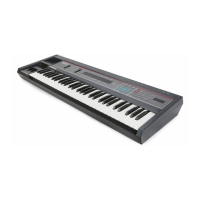SQ-80 — Musician's Manual
8) MERGE
This EDIT Function takes all the Key and Controller Data from one Track and adds, or Merges it together
with another Track. This allows you to record several different Tracks, all with the same Program and
MIDI Configuration, and then Merge them into one. The effect is a kind of Sound-on-Sound — the
ability to add to Track Data rather than replacing it.
This also allows you to Quantize the two Tracks to different Quantization values before Merging them
together. When sequencing a drum part, for instance. you could record the Kick and Snare on one Track,
and Quantize that Track to 1/4 or 1/8th Notes. Then record the Toms on another Track, and Quantize
that Track to 1/8th-note Triplets, or whatever. Then merge the two Tracks together.
After Merging Tracks together, you should Erase the Source
Track, to avoid confusion. and to conserve
your Tracks and your available Memory.
To MERGE a Track Into Another Track:
-> Make sure the Track you want to Merge Into another (the Source Track) is selected. -
>
Select EDIT Page, and press TRACK.
-> Press MERGE — the Display shows the following:
-> Use the Data Entry Slider and
the Up and Down Arrow But-
tons to choose which Track the
selected Track will be Merged
with (the Destination Track).
When the procedure has been
done, all the Key and Controlle
Data from both Tracks will be
on this Track.
Note: The Program, Mix Level, MIDI Channel. Status, and Program Number of the Source Track are
not copied in this procedure — the settings of the Destination
Track remain in effect for the new,
Merged, Track,
-> Press *YES* to Merge the Source Track with the Destination Track. You will then be returned to
the
EDIT TRACK Page. Or Press *NO* to cancel the procedure for any reason.
9) COPY
This is one of the most useful Track EDIT functions. It simply makes a Copy of a Track onto another
Track within the Sequence. You can, for instance, easily double a Track with another Sound, by Copying
it to another Track Location, then assigning the new Track a new Program, MIDI Channel. etc. Or Copy a
Track to another Track Location, then Transpose the new Track up an octave (see
Transpose, p. 122),
for doubling an octave up. Along with the recorded Track Data, the Source
Track's Internal Program,
MIDI Channel, Status, Program Number and Mix Level will be copied to the Destination
Track.
You can't Copy a Track onto a Track Location that has been recorded already. The Destination
,
Track
must be blank — free from recorded Track Data.
Section 4 — The Sequencer 125

